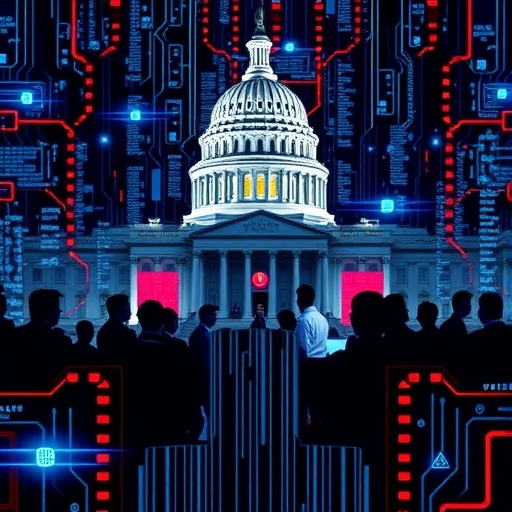House Oversight Committee Launches Urgent Investigation into Massive Federal Cybersecurity Breach Affecting Key Agencies
In a stunning revelation that has sent shockwaves through Washington, the House Oversight and Accountability Committee has initiated a high-stakes investigation into a sophisticated Cybersecurity breach that compromised sensitive databases across multiple federal agencies. The breach, which occurred over the past several months, exposed critical personal data of millions of Americans, including Social Security numbers, financial records, and classified operational details. Committee Chair James Comer (R-KY) announced the probe on Tuesday, vowing to hold accountable those responsible for what he called “a catastrophic failure in our nation’s digital defenses.”
- Hackers Exploit Vulnerabilities in Multi-Agency Networks
- Committee Chair Demands Swift Accountability from Agency Leaders
- Bipartisan Momentum Builds for Cybersecurity Funding Boost
- Broader Implications: Rising Global Cyber Threats Target U.S. Infrastructure
- Path Forward: Hearings, Reforms, and a Resilient Digital Future
This data breach, first detected in late summer, has already prompted bipartisan outrage in Congress, with lawmakers from both sides of the aisle demanding immediate answers and a substantial boost in Cybersecurity funding. The intrusion reportedly originated from a foreign state-sponsored hacking group, though officials have not yet publicly named the perpetrators. As the scope of the damage unfolds, experts warn that this incident could mark the beginning of a new era of vulnerabilities in government infrastructure.
The breach affected at least five major federal agencies, including the Department of Homeland Security (DHS), the Internal Revenue Service (IRS), and the Department of Veterans Affairs (VA). Preliminary reports indicate that hackers gained unauthorized access through a vulnerable third-party software vendor, exploiting outdated patches and weak authentication protocols. This has raised alarming questions about the overall resilience of the U.S. government’s digital ecosystem, especially amid escalating global cyber threats from nations like China, Russia, and Iran.
Hackers Exploit Vulnerabilities in Multi-Agency Networks
The cybersecurity incursion began subtly, with initial phishing attempts targeting low-level employees in the DHS around July of this year. According to a leaked internal memo obtained by this news outlet, the attackers used advanced persistent threat (APT) techniques to burrow deeper into the network, eventually pivoting to interconnected systems in the IRS and VA. By September, the breach had escalated, allowing hackers to siphon off terabytes of data over encrypted channels.
Security analysts from cybersecurity firm Mandiant, who were brought in for damage assessment, described the operation as “one of the most intricate state-sponsored attacks seen in recent years.” The hackers, believed to be linked to a North Korean collective known as Lazarus Group—though unconfirmed—deployed custom malware that evaded detection for weeks. This malware, dubbed “ShadowNet” by investigators, mimicked legitimate administrative traffic, making it nearly invisible to standard intrusion detection systems.
Statistics underscore the severity: The data breach potentially exposed information on up to 15 million individuals, including veterans receiving benefits and taxpayers filing returns. A joint statement from the affected federal agencies revealed that 2.3 million Social Security numbers were compromised, alongside 1.1 million health records from the VA. “This isn’t just a technical glitch; it’s a national security crisis,” said Sen. Mark Warner (D-VA), ranking member of the Senate Intelligence Committee, during a press briefing. “Our adversaries now have a treasure trove of data that could fuel identity theft, espionage, and worse.”
Further details emerged from whistleblower accounts shared anonymously with congressional staff. One DHS insider claimed that budget cuts to the agency’s cybersecurity division—reduced by 12% in the last fiscal year—left critical systems understaffed and unmonitored. “We were sounding alarms for months, but resources were diverted to other priorities,” the source said. These revelations have fueled the Congressional investigation, with subpoenas already issued to agency heads for full briefings.
Committee Chair Demands Swift Accountability from Agency Leaders
Leading the charge in Congress, Rep. James Comer has transformed the House Oversight Committee into a formidable force against bureaucratic inertia. In his opening statement during the first hearing, Comer lambasted the federal agencies for their “complacency in the face of known risks.” He highlighted a 2023 Government Accountability Office (GAO) report that flagged over 300 high-risk vulnerabilities in government networks, many of which remain unaddressed.
The investigation will zero in on three key areas: the timeline of the data breach, the adequacy of response protocols, and the allocation of cybersecurity budgets. Committee members plan to grill top officials, including DHS Secretary Alejandro Mayorkas and IRS Commissioner Daniel Werfel, in closed-door sessions starting next week. “We need transparency now, not excuses,” Comer declared. “American taxpayers deserve to know why their sensitive information was left hanging in the digital wind.”
Bipartisan support is evident, with Rep. Jamie Raskin (D-MD), the committee’s ranking Democrat, co-sponsoring the probe. Raskin emphasized the human cost, noting that compromised VA data could jeopardize veterans’ privacy and benefits. “This breach strikes at the heart of trust in government,” he said. “We must ensure that federal agencies are equipped to protect the people they serve.”
Quotes from other lawmakers paint a picture of unified resolve. Rep. Nancy Mace (R-SC) tweeted, “Time to #SecureAmerica: No more half-measures on cybersecurity.” Meanwhile, Sen. Marco Rubio (R-FL) called for “immediate sanctions on any foreign entities involved.” These voices reflect a rare consensus in a divided Congress, potentially paving the way for legislative action.
Bipartisan Momentum Builds for Cybersecurity Funding Boost
As the investigation gains steam, calls for enhanced cybersecurity measures are echoing across Capitol Hill. A coalition of 45 lawmakers from both parties has introduced the Federal Cyber Defense Act of 2024, proposing an additional $2.5 billion in funding for federal agencies to modernize their digital infrastructure. The bill targets upgrades like zero-trust architecture, AI-driven threat detection, and mandatory multi-factor authentication across all systems.
Proponents cite sobering statistics: According to a recent Verizon Data Breach Investigations Report, 83% of breaches involve human error, often exacerbated by underfunded IT departments. In the U.S. government alone, cybersecurity incidents rose 25% last year, costing an estimated $4.45 billion in recovery efforts. “We’ve been playing catch-up for too long,” said Rep. Abigail Spanberger (D-VA), a former CIA officer and bill co-sponsor. “This data breach is a wake-up call—invest now or pay dearly later.”
The push extends beyond funding. Lawmakers are advocating for a centralized Cyber Command within the executive branch, modeled after the military’s U.S. Cyber Command, to coordinate responses across federal agencies. Industry experts, including those from CrowdStrike and Palo Alto Networks, have testified in preliminary sessions, warning that legacy systems—some dating back to the 1990s—pose existential risks. “Quantum computing threats are on the horizon,” noted CrowdStrike CEO George Kurtz. “Without proactive investment, we’re inviting disaster.”
Public reaction has been swift, with advocacy groups like the Electronic Frontier Foundation (EFF) urging Congress to prioritize user privacy in any reforms. A petition on Change.org has garnered over 100,000 signatures demanding free credit monitoring for affected individuals. This groundswell could pressure agencies to accelerate victim notifications, currently delayed due to the ongoing investigation.
Broader Implications: Rising Global Cyber Threats Target U.S. Infrastructure
The breach is not an isolated event but part of a surging wave of cyber aggression against the U.S. In 2023, the FBI reported a 300% increase in ransomware attacks on government entities, with nation-states like Russia implicated in 40% of cases. This latest incident follows closely on the heels of the 2021 Colonial Pipeline hack and the 2020 SolarWinds supply chain attack, both of which exposed systemic weaknesses.
Intelligence briefings shared with the Congressional investigation committee suggest that adversaries are increasingly targeting federal agencies to sow discord and steal intellectual property. The stolen data from this data breach could enable sophisticated spear-phishing, election interference, or even physical attacks on infrastructure. “Cyber is the new battlefield,” warned Director of National Intelligence Avril Haines in a recent report. “And we’re outgunned if we don’t adapt.”
Economists estimate that unaddressed cybersecurity gaps could cost the U.S. economy $10.5 trillion annually by 2025, per Cybersecurity Ventures. For federal agencies, the fallout includes not just financial losses but eroded public confidence. Surveys show that 62% of Americans now distrust government handling of personal data, a figure likely to climb post-breach.
Internationally, allies like the UK and EU are watching closely. The breach has prompted discussions at the upcoming G7 summit on harmonizing cyber defenses. Domestically, states are stepping up; California Governor Gavin Newsom announced a $500 million state-level cybersecurity initiative in response, citing the federal lapse as a catalyst.
Path Forward: Hearings, Reforms, and a Resilient Digital Future
Looking ahead, the House Oversight Committee’s investigation is set to unfold over the next six months, with public hearings slated for early 2024. Expect rigorous scrutiny of procurement practices, where federal agencies often rely on vendors with spotty security records. Reforms could include mandatory annual audits and penalties for non-compliance, potentially reshaping how Congress allocates budgets.
Optimism tempers the urgency: Bipartisan bills like the Cyber Incident Reporting Act aim to standardize breach disclosures, giving faster warnings to the public. Private-sector partnerships, such as those with Microsoft and Amazon Web Services, could accelerate cloud migrations, reducing on-premise vulnerabilities. “This crisis could be the turning point,” said cybersecurity policy expert Dr. Francesca Spidalieri of the Hoover Institution. “If Congress acts decisively, we can build a fortress around our digital assets.”
For affected Americans, relief measures are in the works: The FTC has greenlit expanded identity theft protections, while agencies promise enhanced monitoring. As the data breach probe deepens, one thing is clear—the era of reactive cybersecurity is over. The path forward demands innovation, investment, and unwavering vigilance to safeguard the nation’s core against invisible foes.








